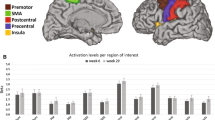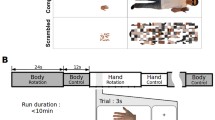Abstract
Stroke has been associated with many changes in motor system function, but there has been limited study of changes in somatotopic organization. This was examined in a group of patients with cortical stroke affecting primary sensorimotor cortex. In 17 patients with good outcome after cortical stroke involving precentral and/or postcentral gyri, plus 14 controls, four functional MRI evaluations of brain activity were obtained: finger, shoulder, and face motor tasks plus a sensory task, passive finger motion. For each, coordinates for contralateral primary sensorimotor cortex activation site were determined, as was a measure of inter-hemispheric balance. The normal motor somatotopy measured in controls was largely preserved after stroke. The main difference found between controls and patients was that the face was lateral to finger motor activation in all controls, but face was centered medial to finger in 43% of patients. Among patients, smaller infarct volume was associated with more ventral, and larger infarct with more dorsal, contralateral primary sensorimotor cortex activation. On the other hand, better behavioral outcome was associated with a more posterior, and poorer outcome with more anterior, activation. Larger infarct and poorer behavioral outcome were each associated with a change in inter-hemispheric balance towards the non-stroke hemisphere. Shifts in contralateral movement representation site did not correlate with changes in inter-hemispheric balance. Motor somatotopy is generally preserved after injury to primary sensorimotor cortex. Greater injury and larger behavioral deficits are associated with distinct effects on movement representation sites. Changes in motor organization within and between hemispheres arise independently after stroke.




Similar content being viewed by others
References
Alkadhi H, Crelier G, Boendermaker S, Golay X, Hepp-Reymond M, Kollias S (2002) Reproducibility of primary motor cortex somatotopy under controlled conditions. AJNR Am J Neuroradiol 23:1524–1532
Belci M, Catley M, Husain M, Frankel H, Davey N (2004) Magnetic brain stimulation can improve clinical outcome in incomplete spinal cord injured patients. Spinal Cord 42:417–419
Blake D, Byl N, Cheung S, Bedenbaugh P, Nagarajan S, Lamb M, Merzenich M (2002) Sensory representation abnormalities that parallel focal hand dystonia in a primate model. Somatosens Mot Res 19:347–357
Bornschlegl M, Asanuma H (1987) Importance of the projection from the sensory to the motor cortex for recovery of motor function following partial thalamic lesion in the monkey. Brain Res 437:121–130
Brown J, Lutsep H, Cramer S, Weinand M (2003) Motor cortex stimulation for enhancement of recovery after stroke: case report. Neurol Res 25:815–818
Byrnes M, Thickbroom G, Phillips B, Mastaglia F (2001) Long-term changes in motor cortical organisation after recovery from subcortical stroke. Brain Res 889:278–287
Calautti C, Baron J (2003) Functional neuroimaging studies of motor recovery after stroke in adults: a review. Stroke 34:1553–1566
Calautti C, Leroy F, Guincestre J, Marie R, Baron J (2001) Sequential activation brain mapping after subcortical stroke: changes in hemispheric balance and recovery. Neuroreport 12:3883–3886
Calautti C, Leroy F, Guincestre J, Baron J (2003) Displacement of primary sensorimotor cortex activation after subcortical stroke: a longitudinal PET study with clinical correlation. Neuroimage 19:1650–1654
Colebatch J, Deiber M-P, Passingham R, Friston K, Frackowiak R (1991) Regional cerebral blood flow during voluntary arm and hand movements in human subjects. J Neurophys 65:1392–1401
Corbetta M, Burton H, Sinclair R, Conturo T, Akbudak E, McDonald J (2002) Functional reorganization and stability of somatosensory-motor cortical topography in a tetraplegic subject with late recovery. Proc Natl Acad Sci U S A 99:17066–17071
Crafton K, Mark A, Cramer S (2003) Improved understanding of cortical injury by incorporating measures of functional anatomy. Brain 126:1650–1659
Cramer S, Nelles G, Benson R, Kaplan J, Parker R, Kwong K, Kennedy D, Finklestein S, Rosen B (1997) A functional MRI study of subjects recovered from hemiparetic stroke. Stroke 28:2518–2527
Cramer S, Moore C, Finklestein S, Rosen B (2000) A pilot study of somatotopic mapping after cortical infarct. Stroke 31:668–671
Cramer S, Mark A, Barquist K, Nhan H, Stegbauer K, Price R, Bell K, Odderson I, Esselman P, Maravilla K (2002) Motor cortex activation is preserved in patients with chronic hemiplegic stroke. Ann Neurol 52:607–616
Cramer S, Benson R, Burra V, Himes D, Crafton K, Janowsky J, Brown J, Lutsep H (2003) Mapping individual brains to guide restorative therapy after stroke: rationale and pilot studies. Neurol Res 25:811–814
Dijkhuizen R, Singhal A, Mandeville J, Wu O, Halpern E, Finklestein S, Rosen B, Lo E (2003) Correlation between brain reorganization, ischemic damage, and neurologic status after transient focal cerebral ischemia in rats: a functional magnetic resonance imaging study. J Neurosci 23:510–517
Elbert T, Flor H, Birbaumer N, Knecht S, Hampson S, Larbig W, Taub E (1994) Extensive reorganization of the somatosensory cortex in adult humans after nervous system injury. Neuroreport 5:2593–2597
Friston K, Worsley K, Frackowiak R, Mazziotta J, Evans A (1994) Assessing the significance of focal activations using their spatial extent. Human Brain Mapping 1:214–220
Fujii Y, Nakada T (2003) Cortical reorganization in patients with subcortical hemiparesis: neural mechanisms of functional recovery and prognostic implication. J Neurosurg 98:64–73
Galea M, Darian-Smith I (1994) Multiple corticospinal neuron populations in the macaque monkey are specified by their unique cortical origins, spinal terminations, and connections. Cereb Cortex 4:166–194
Green J, Sora E, Bialy Y, Ricamato A, Thatcher R (1998) Cortical sensorimotor reorganization after spinal cord injury: an electroencephalographic study. Neurology 50:1115–1121
Green J, Bialy Y, Sora E, Ricamato A (1999) High-resolution EEG in poststroke hemiparesis can identify ipsilateral generators during motor tasks. Stroke 30:2659–2665
Kew J, Brooks D, Passingham R, Rothwell J, Frackowiak R, Leigh P (1994) Cortical function in progressive lower motor neuron disorders and amyotrophic lateral sclerosis: a comparative PET study. Neurology 44:1101–1110
Lee M, Reddy H, Johansen-Berg H, Pendlebury S, Jenkinson M, Smith S, Palace J, Matthews P (2000) The motor cortex shows adaptive functional changes to brain injury from multiple sclerosis. Ann Neurol 47:606–613
Lotze M, Erb M, Flor H, Huelsmann E, Godde B, Grodd W (2000) fMRI evaluation of somatotopic representation in human primary motor cortex. Neuroimage 11:473–481
Lotze M, Flor H, Grodd W, Larbig W, Birbaumer N (2001) Phantom movements and pain. An fMRI study in upper limb amputees. Brain 124:2268–2277
Manger P, Woods T, Munoz A, Jones E (1997) Hand/face border as a limiting boundary in the body representation in monkey somatosensory cortex. J Neurosci 17:6338–6351
Martin P, Naeser M, Theoret H, Tormos J, Nicholas M, Kurland J, Fregni F, Seekins H, Doron K, Pascual-Leone A (2004) Transcranial magnetic stimulation as a complementary treatment for aphasia. Semin Speech Lang 25:181–191
Milliken G, Stokic D, Tarkka I (1999) Sources of movement-related cortical potentials derived from foot, finger, and mouth movements. J Clin Neurophysiol 16:361–372
Nakamura A, Yamada T, Goto A, Kato, Ito K, Abe Y, Kachi T, Kakigi R (1998) Somatosensory homunculus as drawn by MEG. Neuroimage 7:377–386
Netz J, Lammers T, Homberg V (1997) Reorganization of motor output in the non-affected hemisphere after stroke. Brain 120:1579–1586
Nudo R (2003) Functional and structural plasticity in motor cortex: implications for stroke recovery. Phys Med Rehabil Clin N Am 14:S57–76
Nudo R, Wise B, SiFuentes F, Milliken G (1996) Neural substrates for the effects of rehabilitative training on motor recovery after ischemic infarct. Science 272:1791–1794
Penfield W, Boldrey E (1937) Somatic motor and sensory representation in the cerebral cortex of man as studied by electrical stimulation. Brain 60:389–443
Pineiro R, Pendlebury S, Johansen-Berg H, Matthews P (2001) Functional mri detects posterior shifts in primary sensorimotor cortex activation after stroke : evidence of local adaptive reorganization? Stroke 32:1134–1139
Reddy H, Narayanan S, Woolrich M, Mitsumori T, Lapierre Y, Arnold D, Matthews P (2002) Functional brain reorganization for hand movement in patients with multiple sclerosis: defining distinct effects of injury and disability. Brain 125:2646–2657
Rijntjes M, Weiller C (2002) Recovery of motor and language abilities after stroke: the contribution of functional imaging. Prog Neurobiol 66:109–122
Rijntjes M, Tegenthoff M, Liepert J, Leonhardt G, Kotterba S, Muller S, Kiebel S, Malin J, Diener H, Weiller C (1997) Cortical reorganization in patients with facial palsy. Ann Neurol 41:621–630
Rossini P, Caltagirone C, Castriota-Scanderbeg A, Cicinelli P, Del Gratta C, Demartin M, Pizzella V, Traversa R, Romani G (1998) Hand motor cortical area reorganization in stroke: a study with fMRI, MEG and TCS maps. Neuroreport 9:2141–2146
Sanes J, Donoghue J (2000) Plasticity and primary motor cortex. Annu Rev Neurosci 23:393–415
Shimizu T, Hosaki A, Hino T, Sato M, Komori T, Hirai S, Rossini P (2002) Motor cortical disinhibition in the unaffected hemisphere after unilateral cortical stroke. Brain 125:1896–1907
Stippich C, Ochmann H, Sartor K (2002) Somatotopic mapping of the human primary sensorimotor cortex during motor imagery and motor execution by functional magnetic resonance imaging. Neurosci Lett 331:50–54
Talairach J, Tournoux P (1988) Co-planar stereotaxic atlas of the brain. Thieme Medical, New York
Traversa R, Cicinelli P, Bassi A, Rossini P, Bernardi G (1997) Mapping of motor cortical reorganization after stroke. A brain stimulation study with focal magnetic pulses. Stroke 28:110–117
Turner J, Lee J, Schandler S, Cohen M (2003) An fMRI investigation of hand representation in paraplegic humans. Neurorehabil Neural Repair 17:37–47
Weiller C, Ramsay S, Wise R, Friston K, Frackowiak R (1993) Individual patterns of functional reorganization in the human cerebral cortex after capsular infarction. Ann Neurol 33:181–189
Xerri C, Merzenich M, Peterson B, Jenkins W (1998) Plasticity of primary somatosensory cortex paralleling sensorimotor skill recovery from stroke in adult monkeys. J Neurophysiol 79:2119–2148
Acknowledgments
Dr. Cramer was supported by grants from NICHD and American Heart Association, Northwest Affiliate.
Author information
Authors and Affiliations
Corresponding author
Rights and permissions
About this article
Cite this article
Cramer, S.C., Crafton, K.R. Somatotopy and movement representation sites following cortical stroke. Exp Brain Res 168, 25–32 (2006). https://doi.org/10.1007/s00221-005-0082-2
Received:
Accepted:
Published:
Issue Date:
DOI: https://doi.org/10.1007/s00221-005-0082-2




